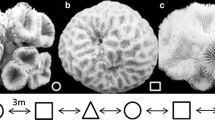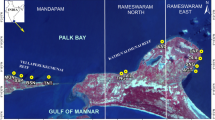Abstract
Syringoporoid tabulate corals are one of the most common benthic sessile organisms in the upper Famennian Etoucun Formation at the Huilong section, Guilin, South China. A multivariate morphometric analysis based on five morphological characters was applied to 29 coralla from three intervals in the formation. Cluster analysis, principal coordinate analysis, non-metric multidimensional scaling, and an examination of the qualitative morphological characteristics revealed the presence of four morphospecies representing Chia hunanensis Jia, 1977, Tetraporinus virgatus Tchudinova, 1986, Fuchungopora multispinosa Lin, 1963, and a new species designated as F. huilongensis. Interval A belongs to foraminifer biozones DFZ4 to DFZ6 and contains abundant C. hunanensis and scattered coralla of T. virgatus, whereas intervals B and C which are within foraminifer biozone DFZ7 contain abundant F. multispinosa, sporadic F. huilongensis, and rare fragmented corallites of C. hunanensis. The coralla are commonly tilted or overturned, which is especially obvious in intervals B and C, indicating that most of them settled on a soft substrate and were subjected to periodic high-energy events. The species of Fuchungopora display flexible growth strategies characterised by the fusion of their corallites. The high diversity of syringoporids recorded from South China indicates an obvious radiation of the tabulate corals in the uppermost Famennian. Syringoporids accounted for the majority of tabulate corals recorded in South China in the upper Famennian and represented a relatively high level of palaeobiodiversity before the Hangenberg Crisis.









Similar content being viewed by others
References
Aretz, M. (2010). Habitats of colonial rugose corals: the Mississippian of western Europe as example for a general classification. Lethaia, 43, 558–572.
Bae, B.-Y., Elias, R. J., & Lee, D.-J. (2006). Morphometrics of Catenipora (Tabulata; Upper Ordovician; southern Manitoba, Canada). Journal of Paleontology, 80, 889–901.
Bae, B.-Y., Elias, R. J., & Lee, D.-J. (2008). Morphometrics of Manipora (Tabulata; Upper Ordovician; southern Manitoba, Canada). Journal of Paleontology, 82, 78–90.
Chen, D. Z., Tucker, M. E., Zhu, J. Q., & Jiang, M. S. (2001). Carbonate sedimentation in a starved pull-apart basin, Middle to Late Devonian, southern Guilin, South China. Basin Research, 13, 141–167.
Chen, D. Z., Guo, Z. H., Jiang, M. S., Guo, C., & Ding, Y. (2016). Dynamics of cyclic carbonate deposition and biotic recovery on platforms during the Famennian of Late Devonian in Guangxi, South China: constraints from high-resolution cycle and sequence stratigraphy. Palaeogeography, Palaeoclimatology, Palaeoecology, 448, 245–265.
Chi, Y. S. (1931). Weiningian (Middle Carboniferous) corals of China. Palaeontologia Sinica, B, XXI(5), 1–70.
Chi, Y. S. (1933). Lower Carboniferous Syringopora of China. Palaeontologia Sinica, B, XXI(4), 1–48.
Dai, M., Liu, L., Lee, D. J., Peng, Y., & Miao, A. (2015). Morphometrics of Heliolites (Tabulata) from the Late Ordovician, Yushan, Jiangxi, South China. Acta Geologica Sinica (English Edition), 89, 38–54.
de Fromentel, E. (1861). Introduction a l'etude des polypiers fossiles. 357 pp. Paris: F. Savy.
Dong, D. Y. (1964). Stromatoporoids from the Early Carboniferous of Kwangsi and Kueichow. Acta Paleontologica Sinica, 12, 280–299.
Dong, D. Y. (2001). Stromatoporoids of China. 423 pp. Beijing: Science Press.
Hammer, O., Harper, D. A. T., & Ryan, P. D. (2001). PAST: paleontological statistics software package for education and data analysis. Palaeontologia Electronica, 4, 1–9.
Hance, L., Muchez, P. H., Coen, M., Fang, X.-S., Groessens, E., Hou, H., Poty, E., Steemans, P. H., Streel, M., Tan, Z., Tourneur, F., Van Steenwinkel, M., & Xu, S.-C. (1994). Biostratigraphy and sequence stratigraphy at the Devonian–Carboniferous transition in southern China (Hunan Province). Comparison with southern Belgium. Annales de la Société géologique de Belgique, 116, 359–378.
Hance, L., Hou, H., & Vachard, D. (2011). Upper Famennian to Viséan foraminifers and some carbonate microproblematica from South China. Beijing: Geological Publishing House.
Hill, D. (1981). Part F, Coelenterata, Supplement 1, Rugosa and Tabulata, Vol. 2. In C. Teichert (Ed.), Treatise on Invertebrate Paleontology (pp. 379–762). Boulder and Lawrence: Geological Society of America and University of Kansas.
Jia, H. Z., Xu, S. Y., Kuang, G. D., Zhang, B. F., Zuo, Z. B., & Wu, J. Z. (1977). Anthozoa. In Palaeontological atlas of central and South China, Late Palaeozoic (pp. 109–270). Beijing: Geological Publishing House.
Jiang, S. L. (1982). Corals. In Ministry of geology and mineral resources, geological memoirs, series 2, stratigraphy and palaeontology (Ed.), Palaeontological atlas of Hunan (pp. 290–347). Beijing: Geological Publishing House.
Kershaw, S. (1994). Classification and geological significance of biostromes. Facies, 31, 81–91.
Li, R. S., Xu, J. B., & Wu, X. H. (2001). Establishment and significance of foraminifera zones of Etoucun FM. – Yingtang FM. In northern Guangxi. Guangxi Geology, 14, 7–12.
Liang, K., Elias, R. J., Choh, S.-J., Lee, D.-C., & Lee, D.-J. (2016). Morphometrics and paleoecology of Catenipora (Tabulata) from the Xiazhen Formation (Upper Ordovician), Zhuzhai, South China. Journal of Paleontology, 90, 1027–1048.
Liang, K., Elias, R. J., & Lee, D.-J. (2018). The early record of halysitid tabulate corals, and morphometrics of Catenipora from the Ordovician of north-central China. Papers in Palaeontology, 4, 363–379.
Liao, W. H. (2004). Coral recovery from the Frasnian-Famennian mass extinction event in South China. In J. Y. Rong & Z. J. Fang (Eds.), Mass Extinction and Recovery — Evidences from the Palaeozoic and Triassic of South China (pp. 259–280). Hefei: University of Science and Technology of China Press.
Lin, B. Y. (1958). New data on Lower Carboniferous syringoporids of the eastern parts of the Tsin-lin. Acta Palaeontologica Sinica, 6, 479–485.
Lin, B. Y. (1963a). Some Tabulata from the Carboniferous and Permian strata of Southern China. Acta Palaeontologica Sinica, 11, 579–596.
Lin, B. Y. (1963b). Some Carboniferous tabulate corals from Nanling range. Professonal Papers Chinese Academy of Geological Sciences, Series B, Stratigraphy and Paleontology, 4, 1–75.
Lin, B. Y. (1985). A preliminary study on the stratigraphical distribution and zoogeographical provinces of the Carboniferous tabulate corals of China. Memorial Geology and Paleontology, 12, 27–46.
Ma, X. P., Gong, Y. M., Chen, D. Z., Racki, G., Chen, X. Q., & Liao, W. H. (2016). The Late Devonian Frasnian–Famennian event in South China — patterns and causes of extinctions, sea level changes, and isotope variations. Palaeogeography, Palaeoclimatology, Palaeoecology, 448, 224–244.
McGhee, G. R. (1996). The Late Devonian mass extinction — the Frasnian/Famennian crisis: critical moments in paleobiology and earth history series (pp. 303). New York: Columbia University Press.
Milhau, B., Mistiaen, B., Brice, D., Degardin, J. M., Derycke, C., Hou, H. F., Rohart, J. C., Vachard, D., & Wu, X. T. (1997). Comparative faunal content of Strunian (Devonian) between Etaoucun (Guilin, Guangxi, South China) and the stratotype area (Etroeungt, Avesnois, north of France). Proceedings of the 30th International Geological Congress, Beijing, 12, 79–94.
Nowinski, A. (1982). Some new species of Tabulata from the Lower Permian of Hornsund, Spitsbergen. Palaeontologia Polonica, 43, 83–96.
Poty, E. (1986). Late Devonian to early Tournaisian rugose corals. Annales de la Société Géologique de Belgique, 109, 65–74.
Poty, E. (1999). Famennian and Tournaisian recoveries of shallow water Rugosa following late Frasnian and late Strunian major crises, southern Belgium and surrounding areas, Hunan (South China) and the Omolon region (NE Siberia). Palaeogeography, Palaeoclimatology, Palaeoecology, 154, 11–26.
Poty, E. (2010). Morphological limitation to the diversification of the rugose and tabulate corals. Palaeoworld, 19, 389–400.
Poty, E., Devuyst, F.-X., & Hance, L. (2006). Upper Devonian and Mississippian foraminiferal and rugose coral zonations of Belgium and northern France: a tool for Eurasian correlations. Geological Magazine, 143, 829–857.
Racki, G. (2005). Toward understanding Late Devonian global events: few answers, and many questions. In D. J. Over, J. R. Morrow, & P. B. Wignall (Eds.), Understanding Late Devonian and Permian–Triassic biotic and climatic events: Towards an integrated approaches developments in palaeontology and stratigraphy (pp. 5–36). Amsterdam: Elsevier BV.
Shen, J. W., & Webb, G. E. (2004a). Famennian (Upper Devonian) calcimicrobial (Renalcis) reef at Miaomen, Guilin, South China. Palaeogeography, Palaeoclimatology, Palaeoecology, 204, 373–379.
Shen, J. W., & Webb, G. E. (2004b). Famennian (Upper Devonian) stromatolite reef at Shatang, Guilin, South China. Sedimentary Geology, 170, 63–84.
Shen, J. W., Yu, C. M., & Bao, H. M. (1997). A Late-Devonian (Famennian) Renalcis–Epiphyton reef at Zhaijiang, Guilin, South China. Facies, 37, 195–260.
Shen, J. W., Webb, G. E., & Jell, J. S. (2008). Platform margins, reef facies and microbial carbonates; a comparison of Devonian reef complexes in the Canning Basin, Western Australia, and the Guilin region, South China. Earth Science Reviews, 88, 33–59.
Sokolov, B. S. (1947). Nobye Siringoporidy Taimyra. Moskovskogo Obshchestva Ispytatelei Prirody. Byulletin (Geologiia), 22, 19–28.
Sokolov, B. S. (1950). Sistematika i istoriya razvitiya paleozoyskikh korallov Anthozoa Tabulata. Voprosy Paleontologii, 1, 134–210.
Sun, N., Elias, R. J., Choh, S. J., Lee, D.-C., Wang, X. L., & Lee, D.-J. (2016). Morphometrics and palaeoecology of the coral Agetolites from the Xiazhen Formation (Upper Ordovician), Zhuzhai, South China. Alcheringa, 40, 1–24.
Tchudinova, I. I. (1986). Sostav, sistema i fllogenlya iskopayemykh korallov. Otryad Sirlngoporlda. Trudy Paleontologlcheskogo Instltuta Akademii Nauk. URSS, 216, 1–205.
Wu, W. S., & Zhao, J. M. (1981). Corals from the Shaodong Formation (Etroeungt) of South China. Acta Palaeontologica Sinica, 20, 1–14.
Yang, S. W. (1978). Tabulata. In Stratigraphy and Palaeontology Team, Guizhou Province (Eds.) Palaeontological atlas of Southwest China, Guizhou volume 2, Carboniferous-Quaternary (pp. 189–228). Beijing: Geological Publishing House.
Yu, J. Z. (1933). Lower Carboniferous corals of China. Palaeontologia Sinica, B, 12, 1–211.
Yu, J. Z. (1934). Description of corals collected from the Maping and the Huanglung limestone in South China. Memoirs of the National Research Institute of Geology, Academia Sinica, 14, 55–82.
Yu, C. M. (1988). Devonian-Carboniferous boundary in Nanbiancun, Guilin, China–aspects and records (pp. 379). Beijing: Science Press.
Yu, C. M., & Shen, J. W. (1998). Devonian reef complexes in Guilin, South China. 168 pp. Nanjing: Jiangsu Science and Technology Publishing House.
Zapalski, M. K., Hubert, B., Nicollin, J., Mistiaen, B., & Brice, D. (2007). The palaeobiodiversity of stromatoporoids, tabulates and brachiopods in the Devonian of the Ardennes—Changes through time. Bulletin de la Societe Geologique de France, 178, 383–390.
Zapalski, M. K., Berkowski, B., & Wrzołek, T. (2016). Tabulate corals after the Frasnian/Famennian crisis: a unique fauna from the Holy Cross Mountains, Poland. PLoS One, 11, e0149767.
Zapalski, M. K., Nowicki, J., Jakubowicz, M., & Berkowski, B. (2017). Tabulate corals across the Frasnian/Famennian boundary: architectural turnover and its possible relation to ancient photosymbiosis. Palaeogeography, Palaeoclimatology, Palaeoecology, 487, 416–429.
Zhang, F. (2016). Recognizing morphospecies in the heliolitid coral Plasmoporella. Palaeoworld, 25, 32–42.
Acknowledgements
We thank C. M. Yu and W. H. Liao for their valuable comments, and Y. D. Chen for the preparation of thin sections. We are grateful to the reviewers, E. Poty and M. Aretz, for providing helpful suggestions.
Funding
This study was supported by grants from the Chinese Academy of Sciences (XDB26000000) and National Science Foundation of China (Grant Nos. 41772004 and 41402013) to KL and WKQ.
Author information
Authors and Affiliations
Corresponding author
Ethics declarations
Conflict of interest
The authors declare that they have no conflict of interest.
Additional information
Publisher’s Note
Springer Nature remains neutral with regard to jurisdictional claims in published maps and institutional affiliations.
This article is a contribution to the special issue ‘Devonian palaeoecosystems and palaeoenvironments of South China’.
This article is registered in Zoobank under: urn:lsid:zoobank.org:pub:4573AB77-E6DA-46BE-83FD-B418BDB97782
Rights and permissions
About this article
Cite this article
Liang, K., Qie, W., Pan, L. et al. Morphometrics and palaeoecology of syringoporoid tabulate corals from the upper Famennian (Devonian) Etoucun Formation, Huilong, South China. Palaeobio Palaeoenv 99, 101–115 (2019). https://doi.org/10.1007/s12549-018-0363-y
Received:
Revised:
Accepted:
Published:
Issue Date:
DOI: https://doi.org/10.1007/s12549-018-0363-y




